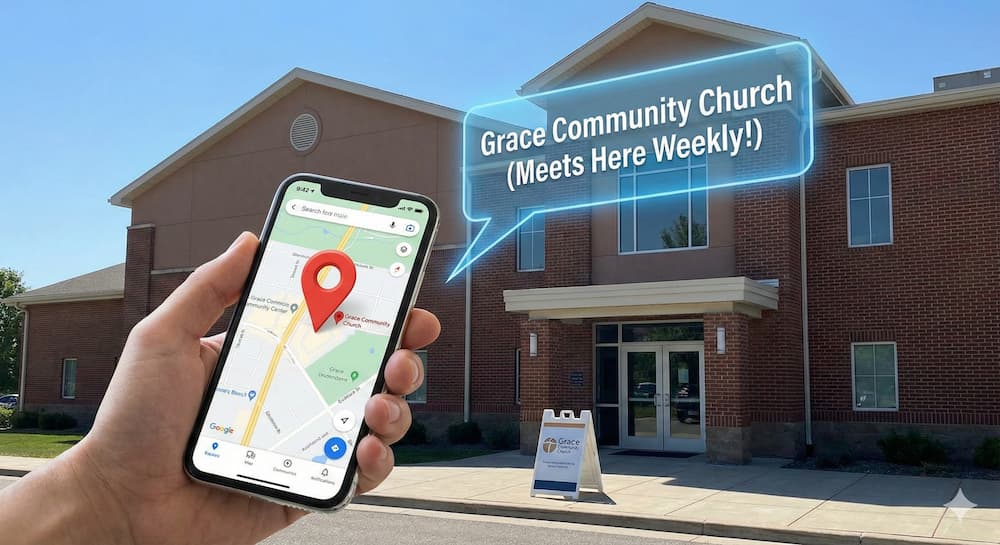Tell Compelling Stories to Increase Giving in Your Church: Here’s How
There are four specific questions every compelling story answers.

Many years ago, before I was a creative arts pastor, I got my start in creative ministry as “the video guy.”
At the time, that meant I mostly created highlight videos from camps or mission trips.
Honestly, it didn’t take a whole lot of skill to do what I was doing. I would just film moments happening on the trips, edit out the bad stuff, keep the good stuff, throw in some music, and call it a day.
One time the pastor I was working with asked for help making testimony videos.
As the video guy, this was my role. However, there was one small issue… I knew how to hit record, make things look decent in the camera, and make highlight videos. I didn’t have the first clue how to tell a story.
Nobody ever taught me anything about that. No one taught me what makes some stories memorable and other stories forgettable.
What I had to learn and discover the hard way is that effective storytelling isn’t as simple as hitting the record button. It’s more than just picking out the right camera or buying the right editing software. It’s about tapping into the power of storytelling to increase online giving.
It took me a while to learn that the effectiveness of your video is far more dependent on how you’re crafting the story than it is on what equipment you use or budget you have. If it was all about the budget and equipment, you would think films like Battleship with its estimated $220 million budget would have been the best movie of the year. But it turns out, if the story isn’t compelling, it doesn’t matter how great the equipment or budget is.
Stories play a crucial role in our churches today, just as they have since the beginning of church. It was Jesus’ chosen method of teaching as we see in Scripture with his parables.
If we can become better storytellers—whether through video, written copy, social media, or other mediums—we’ll have an opportunity to communicate more effectively for our churches.
What is a story?
I define story as “the journey and response of a character facing a conflict.” Sometimes, the character is a person. That story may sound like a man, whose life was falling apart with drug and alcohol abuse, taking a bold step to keep his life and family together.
There are times where the “character” may be your church. As an example, our church is adopting a new village in Guatemala. That story would look like the journey of our church transforming a village in Guatemala that is mired in poverty and lacks clean water.
Other times the “character” is broad and the goal is that the audience puts themselves in the story as the protagonist. For example, that may look like a person who thinks they have nothing to offer God but still has the opportunity to serve and use their gifts.
.png)
Every story is different. But at the end of the day, stories tell the journey and response of a character facing conflict.
Now that we have the concept of what a story is, there are four specific questions I believe every effective story answers.
Question #1: What Is the conflict?
What’s the conflict or problem the character is trying to solve?
Conflict is simply the struggle between two opposing forces. That might be an internal conflict or an external conflict.
Without conflict, you don’t have a story worth telling. Think about what kind of story Star Wars would be if Luke Skywalker never dealt with his past and never faced Darth Vader. Think about what kind of story Shawshank Redemption would be if Andy Dufresne never ended up in jail for crimes he didn’t commit.
Conflict shapes who we are as people and is the key to relating to our audience.
As you identify the story you want to tell, first identify the conflict in the story.
Question #2: What is the solution?
For the internal or external conflict in the story, what was or what could be the solution? What’s going to fix the problem the character is facing?
Here’s the cool thing: We serve a God who is in the solution business. We have the Bible that lays out the very Word of God, which provides a path for us. In the stories we share, we can point to Jesus as the solution.
This was groundbreaking for me, because it changed what I looked for in the type of stories we were sharing as a church. Instead of just focusing on the most sensational stories, I began searching for the simple but relatable stories of people who were facing a conflict and found a solution in something we had to offer as a church.
After you identify the conflict in the story, find the solution—whatever that is. Without it, your story won’t connect.
Question #3: What are the barriers?
There are barriers between the conflict and the solution. These barriers are the things that so often hold us back from reaching the solution to the conflict. Those barriers might be things like fear, anxiety, hopelessness, or doubt.
When you speak to the barriers in the story, you have the opportunity to create a “that’s me” moment with your viewer, because you can speak to the very barriers your audience faces in their own lives.
Question #4: What is the call to action?
Sometimes we need another character, a guide, or an external force for us to overcome those barriers and seek the solution.
When you find the call to action in the story, you identify the thing that compelled someone to change and overcome the barriers they face.
It’s critical for us as the church to zero in on this because the answer to what compelled someone to change is often the same next step others need to take in their own lives.
I found that as I focused on identifying the clear conflict, solution, barriers, and call to action in the story, the impact and reach of the stories we were telling became greater than ever before.
By answering those questions, you have the building blocks for telling meaningful stories that can inspire your audience.
We’re all storytellers.
What story will you tell?
Editor's Note: This is a guest post by Phil Bowdle. Phil is a creative arts pastor and the author of Rethink Communication: A Playbook to Clarify and Communicate Everything in Your Church. Learn more about Phil at PhilBowdle.com.
Sign Up for Product Updates
Many years ago, before I was a creative arts pastor, I got my start in creative ministry as “the video guy.”
At the time, that meant I mostly created highlight videos from camps or mission trips.
Honestly, it didn’t take a whole lot of skill to do what I was doing. I would just film moments happening on the trips, edit out the bad stuff, keep the good stuff, throw in some music, and call it a day.
One time the pastor I was working with asked for help making testimony videos.
As the video guy, this was my role. However, there was one small issue… I knew how to hit record, make things look decent in the camera, and make highlight videos. I didn’t have the first clue how to tell a story.
Nobody ever taught me anything about that. No one taught me what makes some stories memorable and other stories forgettable.
What I had to learn and discover the hard way is that effective storytelling isn’t as simple as hitting the record button. It’s more than just picking out the right camera or buying the right editing software. It’s about tapping into the power of storytelling to increase online giving.
It took me a while to learn that the effectiveness of your video is far more dependent on how you’re crafting the story than it is on what equipment you use or budget you have. If it was all about the budget and equipment, you would think films like Battleship with its estimated $220 million budget would have been the best movie of the year. But it turns out, if the story isn’t compelling, it doesn’t matter how great the equipment or budget is.
Stories play a crucial role in our churches today, just as they have since the beginning of church. It was Jesus’ chosen method of teaching as we see in Scripture with his parables.
If we can become better storytellers—whether through video, written copy, social media, or other mediums—we’ll have an opportunity to communicate more effectively for our churches.
What is a story?
I define story as “the journey and response of a character facing a conflict.” Sometimes, the character is a person. That story may sound like a man, whose life was falling apart with drug and alcohol abuse, taking a bold step to keep his life and family together.
There are times where the “character” may be your church. As an example, our church is adopting a new village in Guatemala. That story would look like the journey of our church transforming a village in Guatemala that is mired in poverty and lacks clean water.
Other times the “character” is broad and the goal is that the audience puts themselves in the story as the protagonist. For example, that may look like a person who thinks they have nothing to offer God but still has the opportunity to serve and use their gifts.
.png)
Every story is different. But at the end of the day, stories tell the journey and response of a character facing conflict.
Now that we have the concept of what a story is, there are four specific questions I believe every effective story answers.
Question #1: What Is the conflict?
What’s the conflict or problem the character is trying to solve?
Conflict is simply the struggle between two opposing forces. That might be an internal conflict or an external conflict.
Without conflict, you don’t have a story worth telling. Think about what kind of story Star Wars would be if Luke Skywalker never dealt with his past and never faced Darth Vader. Think about what kind of story Shawshank Redemption would be if Andy Dufresne never ended up in jail for crimes he didn’t commit.
Conflict shapes who we are as people and is the key to relating to our audience.
As you identify the story you want to tell, first identify the conflict in the story.
Question #2: What is the solution?
For the internal or external conflict in the story, what was or what could be the solution? What’s going to fix the problem the character is facing?
Here’s the cool thing: We serve a God who is in the solution business. We have the Bible that lays out the very Word of God, which provides a path for us. In the stories we share, we can point to Jesus as the solution.
This was groundbreaking for me, because it changed what I looked for in the type of stories we were sharing as a church. Instead of just focusing on the most sensational stories, I began searching for the simple but relatable stories of people who were facing a conflict and found a solution in something we had to offer as a church.
After you identify the conflict in the story, find the solution—whatever that is. Without it, your story won’t connect.
Question #3: What are the barriers?
There are barriers between the conflict and the solution. These barriers are the things that so often hold us back from reaching the solution to the conflict. Those barriers might be things like fear, anxiety, hopelessness, or doubt.
When you speak to the barriers in the story, you have the opportunity to create a “that’s me” moment with your viewer, because you can speak to the very barriers your audience faces in their own lives.
Question #4: What is the call to action?
Sometimes we need another character, a guide, or an external force for us to overcome those barriers and seek the solution.
When you find the call to action in the story, you identify the thing that compelled someone to change and overcome the barriers they face.
It’s critical for us as the church to zero in on this because the answer to what compelled someone to change is often the same next step others need to take in their own lives.
I found that as I focused on identifying the clear conflict, solution, barriers, and call to action in the story, the impact and reach of the stories we were telling became greater than ever before.
By answering those questions, you have the building blocks for telling meaningful stories that can inspire your audience.
We’re all storytellers.
What story will you tell?
Editor's Note: This is a guest post by Phil Bowdle. Phil is a creative arts pastor and the author of Rethink Communication: A Playbook to Clarify and Communicate Everything in Your Church. Learn more about Phil at PhilBowdle.com.
podcast transcript
Many years ago, before I was a creative arts pastor, I got my start in creative ministry as “the video guy.”
At the time, that meant I mostly created highlight videos from camps or mission trips.
Honestly, it didn’t take a whole lot of skill to do what I was doing. I would just film moments happening on the trips, edit out the bad stuff, keep the good stuff, throw in some music, and call it a day.
One time the pastor I was working with asked for help making testimony videos.
As the video guy, this was my role. However, there was one small issue… I knew how to hit record, make things look decent in the camera, and make highlight videos. I didn’t have the first clue how to tell a story.
Nobody ever taught me anything about that. No one taught me what makes some stories memorable and other stories forgettable.
What I had to learn and discover the hard way is that effective storytelling isn’t as simple as hitting the record button. It’s more than just picking out the right camera or buying the right editing software. It’s about tapping into the power of storytelling to increase online giving.
It took me a while to learn that the effectiveness of your video is far more dependent on how you’re crafting the story than it is on what equipment you use or budget you have. If it was all about the budget and equipment, you would think films like Battleship with its estimated $220 million budget would have been the best movie of the year. But it turns out, if the story isn’t compelling, it doesn’t matter how great the equipment or budget is.
Stories play a crucial role in our churches today, just as they have since the beginning of church. It was Jesus’ chosen method of teaching as we see in Scripture with his parables.
If we can become better storytellers—whether through video, written copy, social media, or other mediums—we’ll have an opportunity to communicate more effectively for our churches.
What is a story?
I define story as “the journey and response of a character facing a conflict.” Sometimes, the character is a person. That story may sound like a man, whose life was falling apart with drug and alcohol abuse, taking a bold step to keep his life and family together.
There are times where the “character” may be your church. As an example, our church is adopting a new village in Guatemala. That story would look like the journey of our church transforming a village in Guatemala that is mired in poverty and lacks clean water.
Other times the “character” is broad and the goal is that the audience puts themselves in the story as the protagonist. For example, that may look like a person who thinks they have nothing to offer God but still has the opportunity to serve and use their gifts.
.png)
Every story is different. But at the end of the day, stories tell the journey and response of a character facing conflict.
Now that we have the concept of what a story is, there are four specific questions I believe every effective story answers.
Question #1: What Is the conflict?
What’s the conflict or problem the character is trying to solve?
Conflict is simply the struggle between two opposing forces. That might be an internal conflict or an external conflict.
Without conflict, you don’t have a story worth telling. Think about what kind of story Star Wars would be if Luke Skywalker never dealt with his past and never faced Darth Vader. Think about what kind of story Shawshank Redemption would be if Andy Dufresne never ended up in jail for crimes he didn’t commit.
Conflict shapes who we are as people and is the key to relating to our audience.
As you identify the story you want to tell, first identify the conflict in the story.
Question #2: What is the solution?
For the internal or external conflict in the story, what was or what could be the solution? What’s going to fix the problem the character is facing?
Here’s the cool thing: We serve a God who is in the solution business. We have the Bible that lays out the very Word of God, which provides a path for us. In the stories we share, we can point to Jesus as the solution.
This was groundbreaking for me, because it changed what I looked for in the type of stories we were sharing as a church. Instead of just focusing on the most sensational stories, I began searching for the simple but relatable stories of people who were facing a conflict and found a solution in something we had to offer as a church.
After you identify the conflict in the story, find the solution—whatever that is. Without it, your story won’t connect.
Question #3: What are the barriers?
There are barriers between the conflict and the solution. These barriers are the things that so often hold us back from reaching the solution to the conflict. Those barriers might be things like fear, anxiety, hopelessness, or doubt.
When you speak to the barriers in the story, you have the opportunity to create a “that’s me” moment with your viewer, because you can speak to the very barriers your audience faces in their own lives.
Question #4: What is the call to action?
Sometimes we need another character, a guide, or an external force for us to overcome those barriers and seek the solution.
When you find the call to action in the story, you identify the thing that compelled someone to change and overcome the barriers they face.
It’s critical for us as the church to zero in on this because the answer to what compelled someone to change is often the same next step others need to take in their own lives.
I found that as I focused on identifying the clear conflict, solution, barriers, and call to action in the story, the impact and reach of the stories we were telling became greater than ever before.
By answering those questions, you have the building blocks for telling meaningful stories that can inspire your audience.
We’re all storytellers.
What story will you tell?
Editor's Note: This is a guest post by Phil Bowdle. Phil is a creative arts pastor and the author of Rethink Communication: A Playbook to Clarify and Communicate Everything in Your Church. Learn more about Phil at PhilBowdle.com.
VIDEO transcript
Many years ago, before I was a creative arts pastor, I got my start in creative ministry as “the video guy.”
At the time, that meant I mostly created highlight videos from camps or mission trips.
Honestly, it didn’t take a whole lot of skill to do what I was doing. I would just film moments happening on the trips, edit out the bad stuff, keep the good stuff, throw in some music, and call it a day.
One time the pastor I was working with asked for help making testimony videos.
As the video guy, this was my role. However, there was one small issue… I knew how to hit record, make things look decent in the camera, and make highlight videos. I didn’t have the first clue how to tell a story.
Nobody ever taught me anything about that. No one taught me what makes some stories memorable and other stories forgettable.
What I had to learn and discover the hard way is that effective storytelling isn’t as simple as hitting the record button. It’s more than just picking out the right camera or buying the right editing software. It’s about tapping into the power of storytelling to increase online giving.
It took me a while to learn that the effectiveness of your video is far more dependent on how you’re crafting the story than it is on what equipment you use or budget you have. If it was all about the budget and equipment, you would think films like Battleship with its estimated $220 million budget would have been the best movie of the year. But it turns out, if the story isn’t compelling, it doesn’t matter how great the equipment or budget is.
Stories play a crucial role in our churches today, just as they have since the beginning of church. It was Jesus’ chosen method of teaching as we see in Scripture with his parables.
If we can become better storytellers—whether through video, written copy, social media, or other mediums—we’ll have an opportunity to communicate more effectively for our churches.
What is a story?
I define story as “the journey and response of a character facing a conflict.” Sometimes, the character is a person. That story may sound like a man, whose life was falling apart with drug and alcohol abuse, taking a bold step to keep his life and family together.
There are times where the “character” may be your church. As an example, our church is adopting a new village in Guatemala. That story would look like the journey of our church transforming a village in Guatemala that is mired in poverty and lacks clean water.
Other times the “character” is broad and the goal is that the audience puts themselves in the story as the protagonist. For example, that may look like a person who thinks they have nothing to offer God but still has the opportunity to serve and use their gifts.
.png)
Every story is different. But at the end of the day, stories tell the journey and response of a character facing conflict.
Now that we have the concept of what a story is, there are four specific questions I believe every effective story answers.
Question #1: What Is the conflict?
What’s the conflict or problem the character is trying to solve?
Conflict is simply the struggle between two opposing forces. That might be an internal conflict or an external conflict.
Without conflict, you don’t have a story worth telling. Think about what kind of story Star Wars would be if Luke Skywalker never dealt with his past and never faced Darth Vader. Think about what kind of story Shawshank Redemption would be if Andy Dufresne never ended up in jail for crimes he didn’t commit.
Conflict shapes who we are as people and is the key to relating to our audience.
As you identify the story you want to tell, first identify the conflict in the story.
Question #2: What is the solution?
For the internal or external conflict in the story, what was or what could be the solution? What’s going to fix the problem the character is facing?
Here’s the cool thing: We serve a God who is in the solution business. We have the Bible that lays out the very Word of God, which provides a path for us. In the stories we share, we can point to Jesus as the solution.
This was groundbreaking for me, because it changed what I looked for in the type of stories we were sharing as a church. Instead of just focusing on the most sensational stories, I began searching for the simple but relatable stories of people who were facing a conflict and found a solution in something we had to offer as a church.
After you identify the conflict in the story, find the solution—whatever that is. Without it, your story won’t connect.
Question #3: What are the barriers?
There are barriers between the conflict and the solution. These barriers are the things that so often hold us back from reaching the solution to the conflict. Those barriers might be things like fear, anxiety, hopelessness, or doubt.
When you speak to the barriers in the story, you have the opportunity to create a “that’s me” moment with your viewer, because you can speak to the very barriers your audience faces in their own lives.
Question #4: What is the call to action?
Sometimes we need another character, a guide, or an external force for us to overcome those barriers and seek the solution.
When you find the call to action in the story, you identify the thing that compelled someone to change and overcome the barriers they face.
It’s critical for us as the church to zero in on this because the answer to what compelled someone to change is often the same next step others need to take in their own lives.
I found that as I focused on identifying the clear conflict, solution, barriers, and call to action in the story, the impact and reach of the stories we were telling became greater than ever before.
By answering those questions, you have the building blocks for telling meaningful stories that can inspire your audience.
We’re all storytellers.
What story will you tell?
Editor's Note: This is a guest post by Phil Bowdle. Phil is a creative arts pastor and the author of Rethink Communication: A Playbook to Clarify and Communicate Everything in Your Church. Learn more about Phil at PhilBowdle.com.



























